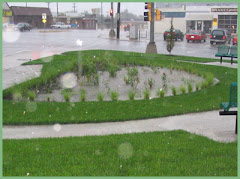Original Graphic Ideas

I've been thinking long and hard about what my original graphic should be for my research report. I'm sort of leaning towards a retention/recycle inspired schematic like this one at Dockside Green in Victoria (top left). A CAD detail of a rain barrel and cross section view of a typical green roof construction and/or rain garden. I also want to add some pictures of buildings using rain barrels if there are any in Kamloops. If anyone knows of a building that utilizes rain barrels somewhere in their neighbourhood, let me know, it would be a great help.
Planning Outline
EDDT 231
Applied Research Project Outline
Project:
Determining what measures can be taken to keep storm water retained on-site, how it can be recycled back into the building envelope and show how they apply to a specific building site.
Methods:
1.) State why storm water retention should be implemented. Naturalize the land again; help improve eco-system, healthier subdivisions.
2.) Talk about the meaning of retention for a building site. Problems a building site may have in conveying storm run-off. Significance of retention.
3.) Apply a design to a residential/commercial building site. Show the design and specifications of storm water retention recycling systems on elevation, floor plan, and building site drawings.
4.) Explain the change of design standards for municipalities. Over-capacity storm sewers, re-charging ground water, reducing amount of runoff into streams.
5.) Give a background on the measures used to help retention. Show statistics based on several projects throughout North America. Green roofs, roof rainwater storage units, rain gardens.
6.) Talk to engineers at work about their experience on design storm water retention systems for subdivisions and try to implement a design to a specific site.
7.) Read government reports on green roofs and their retention capabilities. Find effectiveness of cisterns, rain gardens. Look at comparison of roof storage tanks specs.
8.) Can alternate storm water management that is applied be effective, appealing, cost efficient? Cost/Benefit of retention based design vs. conventional storm sewers.
Special Problems:
1.) Environmental impacts of conventional storm sewers. Damage to streams and the habitat of wildlife depending on those streams is a major concern. Pollutants can enter the storm system with little or no treatment and into the streams.
2.) Cost of storm water retention systems. Does it cost more than conventional systems? Less? Do the benefits of a retention friendly system outweigh the cost? Should cost even be an issue?
3.) Are retention measures effective? Show statistics of several projects throughout North America using retention systems and prove how they work. Draw a comparison between conventional sewers and retention systems.
4.) Where in North America will recycled storm retention systems be beneficial? Coastal regions, with large amounts of rainfall. Can these systems work in semi-arid regions, like Kamloops?
5.) How often do materials used in recycling practices need replacing? Do they wear down easily/need maintenance?
6.) Which methods of retention recycling are more effective? Does it matter on a given design? Can these methods be combined for a given project?
7.) How is greywater treated back into the building? What can this water be used for? What chemicals are used to clean the water?
Also:
1.) What scale of size should retention systems be to? Should rooftop storage tanks, rain gardens, and green roofs all be used in a single building?
2.) Performance of roof storm water retention tanks. What ones work better and take up less square footage to be effective enough?
3.) Rain gardens and above ground cisterns can promote growth to mosquito larva increasing the risk of West Nile virus. What measures are taken to prevent hatching? Sprinklers, additives to water?
4.) How can storm water retention recycled systems be integrated with other green technologies? Create hydro-electric energy with storm run-off?
5.) Calculating storm run-off flow. Manning’s equation or computer modeling techniques used in engineering offices to find out how much run-off will enter sewers and streams. Compare conventional sewer run-off to a recycling system.
6.) Do land values increase with implementation of greener storm water retention technology? Quality of life of those living in the building increase?




4 comments:
I was talking to a potential client this weekend and he was telling me that the only thing that might stop him from buying a piece of property in Knuttsford (South of Kamloops) is the fact that the two wells on the site may not produce enough water to support the house that he wants to build. It sounds like we could incorporate some rain barrels into the design.
I would recommend that you find a specific project (not necessarily the one described above) to apply your research to. This should make it much easier to sketch up your schematic.
Thanks Dale
I think I will use a project in Kamloops, seems like Arizona and Texas like to use rain barrels, they somewhat have the same climate as Kamloops.
Derek Buddeh,
I got a whole wack load of site plans, We will have to meet up soon and you can pick one to use. Also, you could use the house, or roof plan if that can help you out with other drwgs.
Hope it helps fuzzy little man peach.
I was doing some research for myself and came across this website.
Hope this helps you out for some ideas. http://commons.bcit.ca/greenroof/case.html
Post a Comment